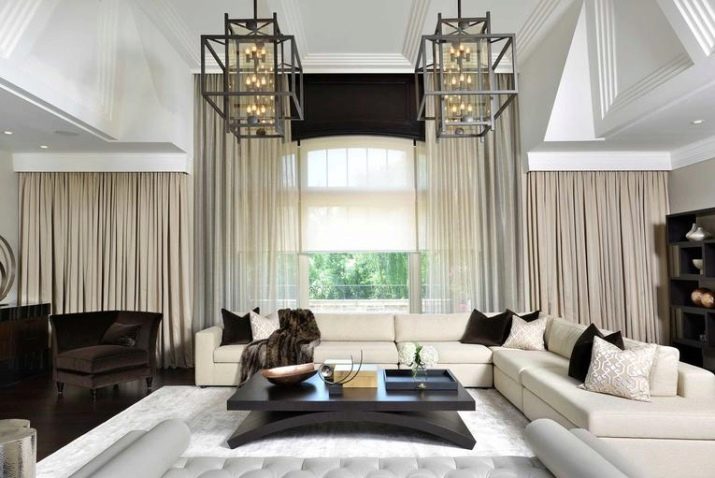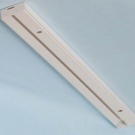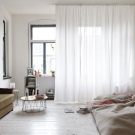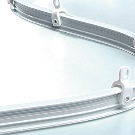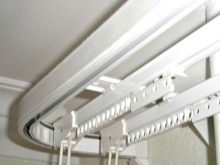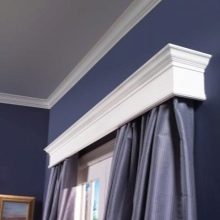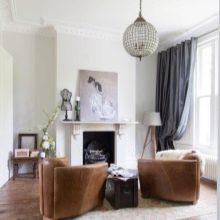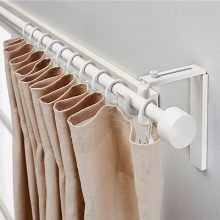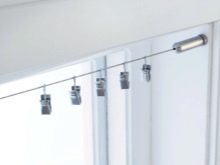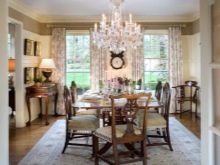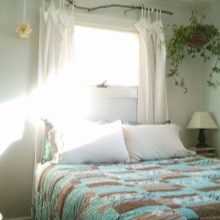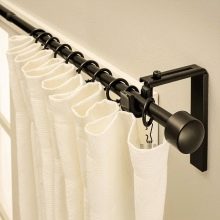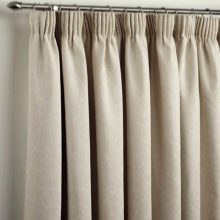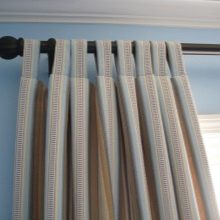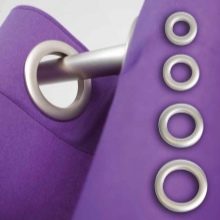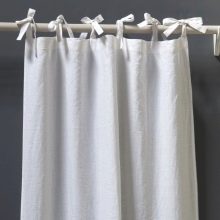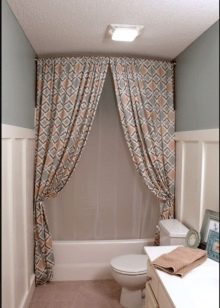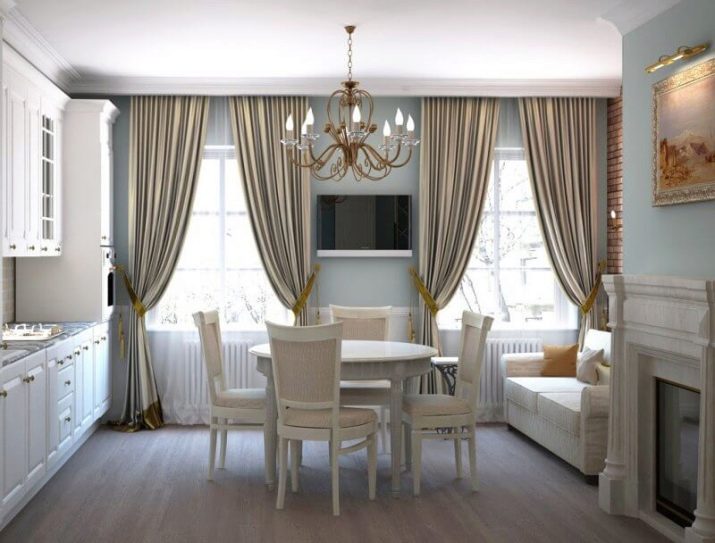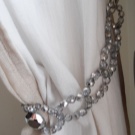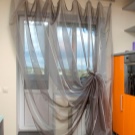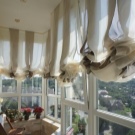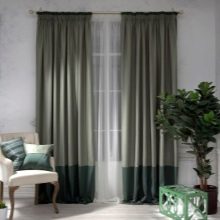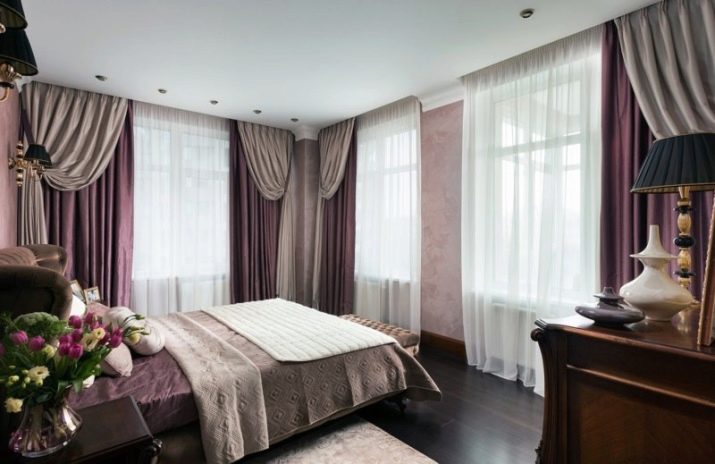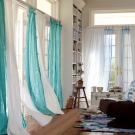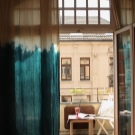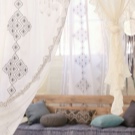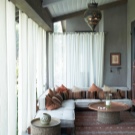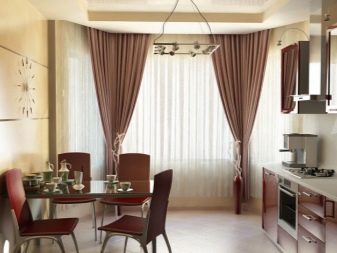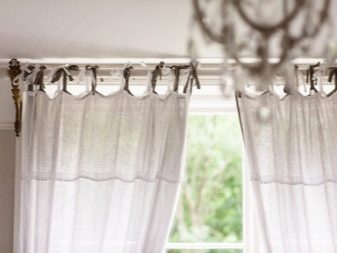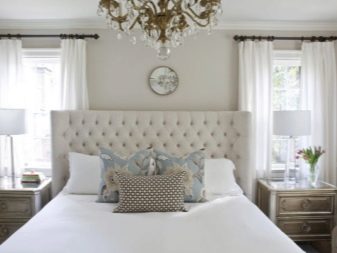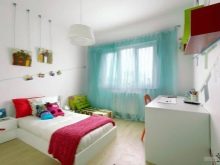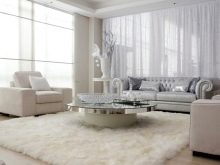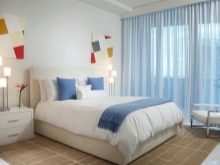How beautiful to hang tulle?
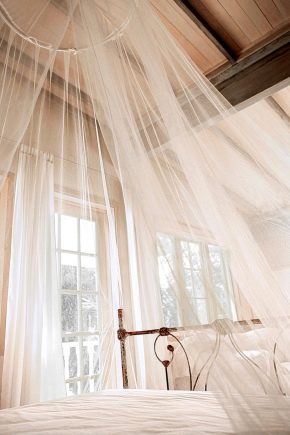
The window is an important element of the living room. Currently, there are many design options for window designs. Today you will learn how to hang tulle beautifully so that the interior of the room becomes more attractive and harmonious.
Kinds of cornices
For a beautiful design of windows you need to find attractive curtain rods that are suitable for the style of the interior of the room. Options may be as follows:
- The simplest and most affordable is the classic ceiling cornice. It is suitable for curtains and curtains of any size.Ceiling elements are plastic niches with guides, to which hooks are attached and tulle is hung up. As a rule, they are attached to the ceiling with simple screws.
Such cornices are simple single, double and so on. Thanks to this diversity, you can create an interesting multi-layer composition.
Such products are flexible. Complete with them comes fittings. Most often these are beautiful corner details, plugs and so on. With the help of such components it is possible to form designs of interesting shapes.
Such details are suitable options for the design of standard windows. Often, a ceiling cornice is attached along a wall with a window.
- There is also such type of eaves, as telescopic. This option is ideal for window decoration in the bathroom, but it is often used for ordinary window openings. This design consists of a telescopic tube, which must be installed in a spacer in a limited space. Telescopic curtain rods are particularly useful and convenient if your windows do not have a wide width.
- A variety of compositions of curtains and curtains can be made through the profile cornices. As a rule, these parts are metallic. They are made of a light aluminum profile, which easily holds the most complex and voluminous compositions. It can be thick multi-layer curtains.
Today profile eaves with automated systems are very popular. They are controlled by remote controls or special light sensors.
- Beautiful baguette cornices are made from a variety of materials. Today in the shops you can find products made of wood, metal or plastic. Such elements have a plank of wood, which is not found in other types of cornices. Thanks to this detail, all internal components of the structure are closed and insulated. Framing rods are ideal for rooms with high ceilings.
- Very common is the tubular cornice. As a rule, such parts are wall console structures. There are special mounts for curtains, which are attached to wide rings and move along the main tube.Tubular ledges are not the most practical, as the tube over time accumulates a thick layer of dust and dirt, due to which the movement of curtains is significantly hampered.
- The hooks for the curtains in the string eaves move along stiff strings. Such designs are very simple. In case of malfunctions they are easily repaired. But it is worth considering the fact that the tension of the strings gives a considerable load on the fastenings of the cornice. Because of this, over time, fasteners can fly out of the right place.
Often the strings in such eaves are closed with a decorative lath, but there are also simple open versions.
- A round cornice is equipped with a wooden or other solid bar at the base. Such species are very common. In them, the main tube has a diameter of 1-4 cm, and an additional one is not more than 3 mm.
How to hang a curtain, if there is no eaves?
The cornice is often an attractive and useful piece, but tulle can be hung without it. For this you can use, for example, beautiful tree branches. If you decide to decorate the interior with similar elements, then they should be pre-treated and varnished.
Tulle can be attached directly to the wall above the window opening.For this you can use metal or plastic hooks and clips.
Some owners turn to a more radical way and hang tulle with a construction stapler. To do this, you need to attach the fabric Velcro on the bracket to the wall or a special frame. Tulle will be attached to the sticky details.
The main disadvantage of such methods is that it will be impossible to move the tulle away.
The choice of accessories for mounting
There are three types of fastenings, using which, you can attach the tulle to the cornice or wall:
- Clothespins rings. Similar types of fastenings are the simplest. They are attached to the eaves and rings. Rings are attached to the fabric with clips or other small details.
- Textiles can be attached to the eaves or make beautiful folds from it, using clothespins.
- Clothespins rings can be made invisible and just hide them behind a cloth curtain.
- With the help of such fasteners will create a beautiful wave-like composition.
- Eyelets. These convenient fasteners allow you to open and close the tulle as quickly and easily as possible.However, they also have their drawback: it is rather difficult to sew such parts, therefore it is not recommended to buy them separately. With the help of eyelets, you can create beautiful and deep folds of fabric.
- Hinges and ties Today in the shops you can find tulles and curtains, in which the loops are originally sewn to the fabric. Often there are options for fasteners - stickies and ties. It should be noted that the loops on the strings are not the most convenient, if we talk about the convenience of opening and closing the canvas. However, this type of attachment is ideal for eaves with embossed patterns or decorative elements.
- An interesting and attractive look curtains in which ties on the eaves are decorated in the form of charming bows. Such elements will fit well into the interiors in the styles of retro, Provence or eco.
Types of assembly and decor options
If you want to decorate the interior and emphasize its individuality, then you should turn to elegant tulle with drapery. You can tie or fold the fabric in an original way, and as a result you will have a truly beautiful thing that will attract attention.
There are three types of drapery fabrics:
- One sided. In this case, the material is laid in one particular direction.
- Counter For this drape, folds of material are laid towards each other.
- Bantovoy. This drapery is exactly the same as the counter, but turns on the opposite side.
For draping fabrics, you can use special magnets. With these details, tulle can be given a very elegant and attractive shape. For example, to refresh the interior, you should gently pick up the curtains with a beautiful magnet with shiny stones or a bright hair clip.
You can tie the material on top or on both sides. Such a simple technique will make the tulle more lush and elegant.
Hairpins and magnets can be simple and solid or decorated with colored stones, beads, contrasting patterns, colors and so on. These elements are small, but they can be used to transform tulle, making it truly luxurious.
How to combine curtains and drapes?
Curtains look very impressive along with the curtains. Curtains of airy fabric in combination with thick and heavy curtains look very nice and elegant.
Today for home interiors are widely used double-sided curtains on the grommet and thick curtains with lambrequins.
Materials may have contrasting colors. Most often the curtains are light, and the curtains are distinguished by rich colors.
Portieres can be draped. For example, it can be deep iridescent folds against the background of light translucent curtains. Curtains can be assembled with magnets or hairpins to make the combination more beautiful.
Ways
- To "revive" the interior, you can use tulle of different colors. This design technique is quite simple, but with it, the decor can play with new colors.
- Warm and cold. It is not a secret for anyone that for rooms located on the north side it is necessary to pick up things of warmer tones, and for southern rooms - elements of cool shades. For “cold” spaces, white-orange curtains will be the ideal solution.
- Harmony and accents. The color of the tulle may overlap with the decoration and furnishings of the room or be a bright accent of the interior. To make the decor seem more harmonious, it is recommended to repeat the color range of window drapery in the decor or textiles of the room.
- Color and texture. Curtains can be combined using several fabrics of the same type, but having different shades.
- Drawings and patterns. With the help of matching patterns and patterns can be identified thematic direction of the interior.
Useful tips
Hanging tulle quickly and symmetrically can be as follows:
- First you need to distribute the same number of cornice hooks on each curtain.
- Then you need to take one canvas and fasten it on the eyelet on the curtain tape for the extreme hooks of the cornice.
- Now you need to find the central hook. It is necessary to hang a tulle on the middle loop.
- As a result, you get two canvases that are attached to the extreme and central hooks. Now you need to find a hook on the eaves in the middle and the central loop on one of the canvases. Catch them, then continue to hang the curtains on the same principle.
- In a similar way, you can hang tulle, but on the other half of the eaves, which is located closer to the window.
In more detail about how beautifully to hang up tulle, you learn from the following video.
Tulle window decoration ideas
- Coffee curtains, collected in the lower part, and white tulle will look good against the background of the bay window in the pale lemon kitchen. The floor in such a room can be finished with white glossy tiles, and the ceiling can be made multi-layered and light. Place in front of the window opening white kitchen set on one wall, a chocolate table with chairs - on the other.
- Interesting and fashionable in many interiors looks tulle with ties. Particularly attractive are products in which the upper part is represented by a separate tape of a contrasting color. For example, chocolate-colored strings will stand out against the light walls and white on a blue background.
- In a bright bedroom with a white eco-leather bed, you can hang straight translucent linen (on dark wooden curtains). Complete the interior with a gilded ceiling chandelier in a classic style, bedside tables of a dark golden color and pillows of blue, black and white tones.
- The soft blue tulle can be hung on the windows in the snow-white children's bedroom with a light beige laminate flooring. Put in such a room a white bed with cushions of rich colors and a red blanket, and in front of her is a white computer desk with a cupboard and a brown chair.The interior can be decorated with a red wall shelf and applications over the bed.
- For a bright kitchen with soothing shades of furniture, pastel-colored tulle options are suitable. For example, in a room with a light table, gray chairs and a blue chandelier, you should hang delicate blue fabrics, and in a room with a light brown table and delicate blue chairs, pink ones.
- White tulle will look good against the background of a large window - in a beige room with a light cream floor. Put in this room a light gray leather sofa with elegant armrests and carnations, as well as white leather chairs and a glossy coffee table in between. Lay a fluffy white carpet on the floor and complete the interior with white vases and neutral decorative pillows.
- In the children's room with two single beds, white walls and soft blue stretch ceiling, harmoniously green tulle will look harmoniously. The floor in such a room should be finished with soft brown laminate. Place the beds near the right and left walls, place tables of soft-heavenly tones at their headboards. Complete the interior with a beautiful chandelier in the shape of a flower, fresh flowers and photo frames.
- Beautiful blue tulle should be hung in a room with white walls and soft chocolate floors. Put a high light bed with white linens, blue pillows and a blue blanket, as well as white bedside tables and a light chair opposite. Complete such a delicate interior with wall paintings combining several bright colors and metal table lamps with white shades.

